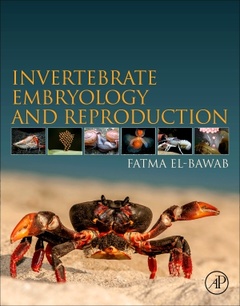Description
Invertebrate Embryology and Reproduction
Author: El-Bawab Fatma
Language: English
Subject for Invertebrate Embryology and Reproduction:
Keywords
Acoela; Alternation of generation; Amphineura; Anthozoa; Archaeocytes; Ascaris megalocephalas; Ascidian tadpole larva; Biradial symmetry; Brachyura; Brooding; Calcispongia; Carrier-cell; Cell lineage; Cerebratulus lacteus; Chitin; Choanocytes; Chromatin diminution; Ciona; Cirripedia; Cnidaria; Coenorabditis elegans; Colloblast; Comb plates; Composite egg; Courtship; Crabs; Crustacea; Ctenophora; Cydippid larva; Dauerlarva; Decapoda; Development; Direct development; Duet cleavage; Enterogona; Gastropoda; Gemmule; Hardening; Hermaphroditism; Hydrozoa; Lineages; Lineus viridis; Luther’s larva; Medusa; Meroblastic cleavage; Mollusca; Müller’s larva; Nauplius larva; Nematoda; Nemertinea; Nidamental glands; Octopus; Ooplasmic segregation; Parthenogenesis; Penaeidea; Phenolic tanning; Pilidium larva; Planula larva; Pleurogona; Polyp; Polyplachophora; Porifera; Prawns; Proboscis; Protandry; Quartet spiral cleavage; Regeneration; Rhabdocoela; Schmidt’s larva; Scyphozoa; Sepia officinalis; Spermatophore; Spicules; Spiral cleavage; Sponge; Spongin; Stereogastrula; Styela; Tricladida; Trochophore larva; Turbellaria; Urochordata; Veliger larva; Vitellogenesis
931 p. · 21.4x27.6 cm · Paperback
Description
/li>Contents
/li>Readership
/li>Biography
/li>Comment
/li>
Invertebrate Embryology and Reproduction deals with the practical and theoretical objectives of the descriptive embryology of invertebrates, along with discussions on reproduction in these groups of animals. It explains several morphological and anatomical expressions in the field and covers the embryology of invertebrate animals, starting from the Protozoa, to the Echinodermata, the Protochordate and Tunicates. These groups include economically important aquatic invertebrates, such as crustaceans, as well as medically important invertebrates and economic arthropods. Each chapter is preceded by the taxonomy of the discussed phylum and/or the species to enable the reader to locate the systematic position.
1. Historical Review2. Introduction3. Kingdom Protista4. Porifera (parazoa)5. Cnidaria6. Ctenophores7. Platyheminthes8. Nemertea9. Nematoda10. Annelida11. Archiannelides12. Oligocheata13. Hirudinea14. Arthropods15. Mollusca16. Echinoderm17. Tunicata
Researchers in the field of crustacean reproduction biology, invertebrate reproductive biology, invertebrate physiology, zoology, comparative reproductive biology and endocrinology, evolutionary biology, aquaculture, animal behavior, and advanced UG/grad students and instructors in these areas. Aquaculture practitioners will also find it useful for their hatchery operations.
- Covers phylum definition, general characteristics, classification, reproduction, agametic reproduction, gametic reproduction, spawning, fertilization, development and embryogenesis
- Includes recent findings in the area, along with detailed figures and photos that illustrate important concepts
- Brings together difficult-to-obtain research data from the field, not only in Egyptian libraries, but globally, and previously only found through specialized references not widely available
- Clarifies descriptions with striking photos and electron microscopical studies of different species




